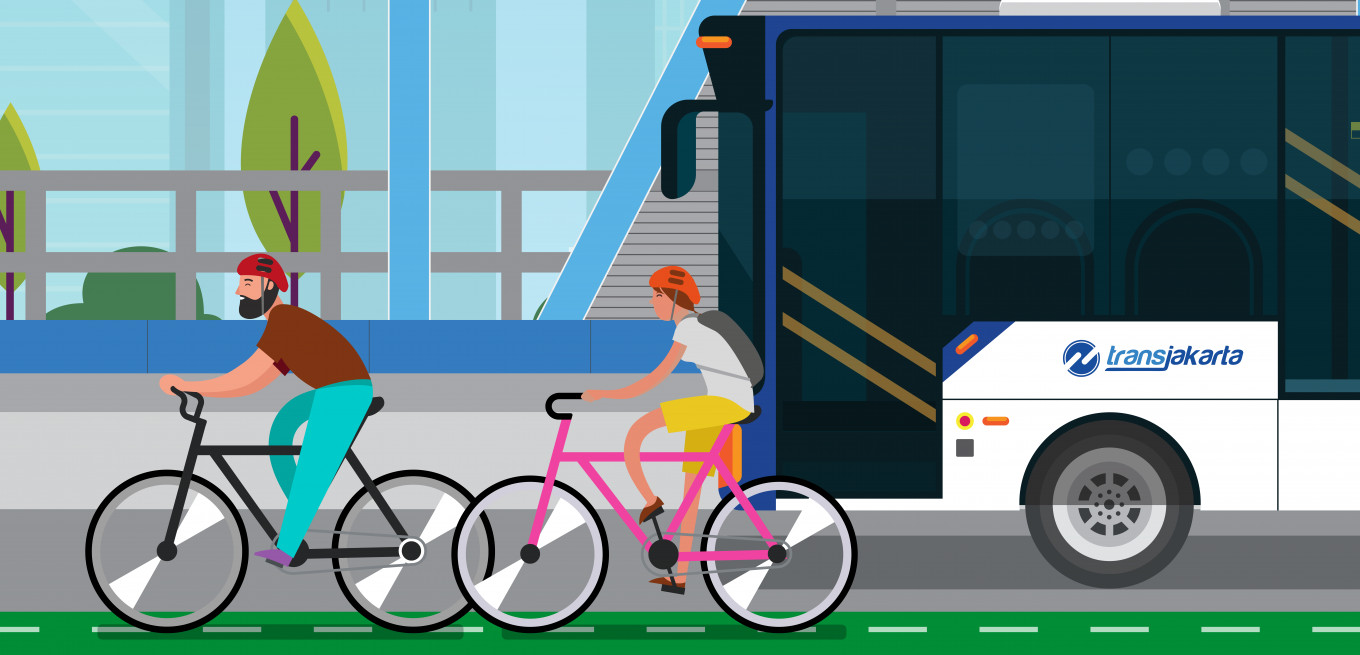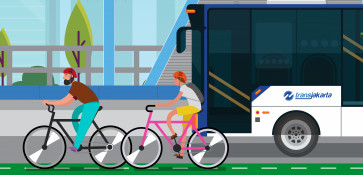Popular Reads
Top Results
Can't find what you're looking for?
View all search resultsPopular Reads
Top Results
Can't find what you're looking for?
View all search results
- -
- Fri, November 3, 2023
Change text size
Gift Premium Articles
to Anyone
Work It Right is a weekly column that provides practical and insightful advice on the complexities of urban transportation.
The debate over bicycle lanes in Jakarta has heated up again after Jakarta transportation authorities removed stick cone bicycle lane separators and downgraded them to reflective cat’s eyes/road studs. The reactions are not surprising from non-bicycle lane users, from saying that the infrastructure is a waste to demands to remove the bicycle lanes altogether.
Ironically, air pollution continues to besiege Jakarta, affecting both the poor and the rich. And the bicycle is one of the few modes of transportation other than walking that does not produce tailpipe emissions, which are the primary cause of air pollution in Jakarta.
Congestion in Jakarta causes annual economic losses of up to Rp 100 trillion (US$6.3 billion), according to 2019 data from the National Development Planning Agency and the 2019 Greater Jakarta Urban Transportation Policy Integration Phase 2. It also causes 100,000 traffic accidents yearly, according to the National Police and 2019 data from Statistics Indonesia. This data came before the development of protected bicycle lanes in Jakarta, such as those in Sudirman, so saying that bicycle lanes cause traffic congestion and traffic accidents for motorcycles and cars in Jakarta is absurd.
Various studies from various organizations show that transportation is the largest contributor to Jakarta’s air pollution, with motorbikes and cars being among the main contributors.
According to data from the Jakarta Environment Agency and Vital Strategies in 2020, the transportation sector, as the largest contributor, is responsible for 67.03 percent of emissions of PM 2.5. So while some Jakartans complain about air quality and traffic, they also champion motorized vehicles, a significant cause of air pollution, by calling for the removal of bike lines, which encourage eco-friendly travel. Where is the logic in that?
Jakartans have been served by four railways – the MRT, LRT Jakarta, LRT Jabodebek and the KRL Commuterline – and one public bus system, Transjakarta, for more than a decade. You can see the gap in the quality of these services in the Lebak Bulus area, where you can still see angkot (public minivans) side by side with electric buses and MRT trains. The saturation of the services in Jakarta proves that Jakarta’s public transportation is far better than other regions in Indonesia.
So why is there still congestion and air pollution? Because Jakarta does not have strong regulations to control the use of private motorized vehicles, the primary polluters.
Bicycle lanes are a promising opportunity to reduce the domination of cars and motorcycles in the city. Bicycle lanes allow commuters to travel by bike for their daily trips. The development of dedicated bicycle lanes symbolizes that road space is not only for cars and motorbikes. This space division is fundamental when cities want to prioritize cyclists and pedestrians, the zero tailpipe emissions contributors, in a car-oriented city.
Bicycle lanes protect all cyclists, regardless of gender, age and skill level. And if they are integrated with public transportation, they can make it easier for cyclists to travel long distances by mixed commuting. In addition, appropriately designed bicycle lanes also have the potential to serve short trips (less than 5 kilometers) that are currently dominated by motorbikes.
Data from the Transportation Ministry's Greater Jakarta Transportation Agency (BPTJ) from 2017 indicates that of the 10 million daily car and motorbike trips within Jakarta, more than 44 percent are trips of less than 10 km.
If this number of cars and motorcycles could be replaced by bicycles and public transportation, how many million tonnes of carbon and pollutants would Jakarta's air be spared, and how much money could we save from limiting congestion?
These big numbers don’t even include how motorcycles and cars lessen the chance of you and the generations after you having a house in the city because the buildings in the city center are full of empty cars and motorcycle parking.
Jakartans have to struggle to get to work, spending hours in traffic, whether using their own cars or motorcycles or public transportation, just because we think that cars and motorbikes are the only modes of transportation to mobilize in the city. Therefore, robust regulations to control motorized vehicle use are urgently needed to cut the rising air pollution and greenhouse gasses for a livable and inclusive city.
-- Have a question about urban transportation? Send it to wir@thejakartapost.com with your name and current location (anonymous submissions will also be considered). Please note that The Jakarta Post reserves the right to edit your letters for publication.
***
Senior communications and partnership manager at the Institute for Transportation and Development Policy (ITDP).
Have a question about urban transportation? Send it to wir@thejakartapost.com with your name and current location (anonymous submissions will also be considered). Please note that The Jakarta Post reserves the right to edit your letters for publication.









